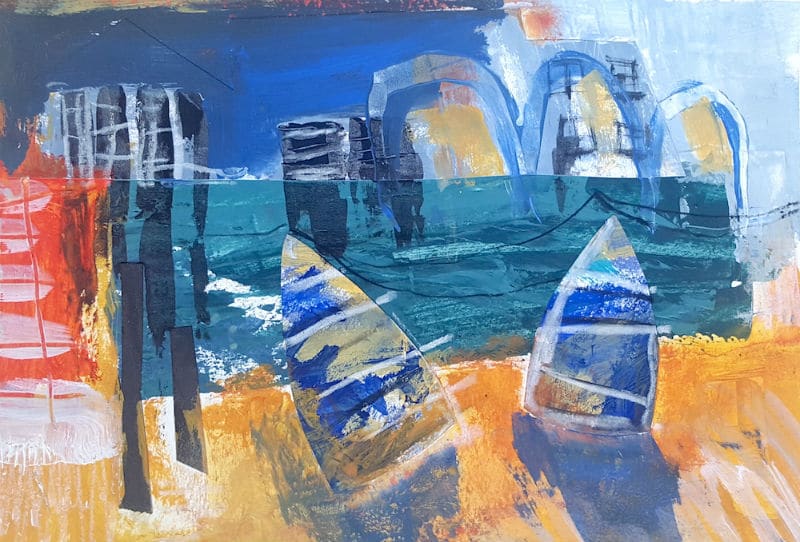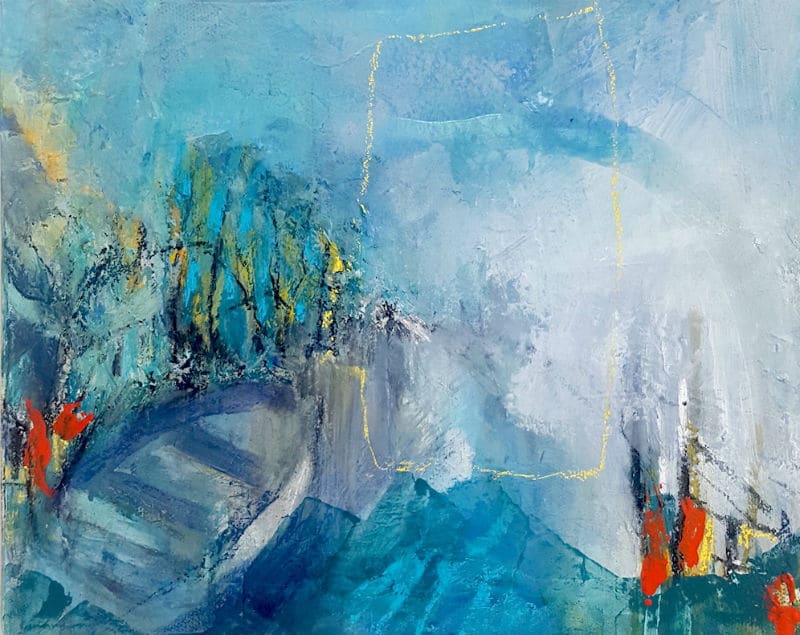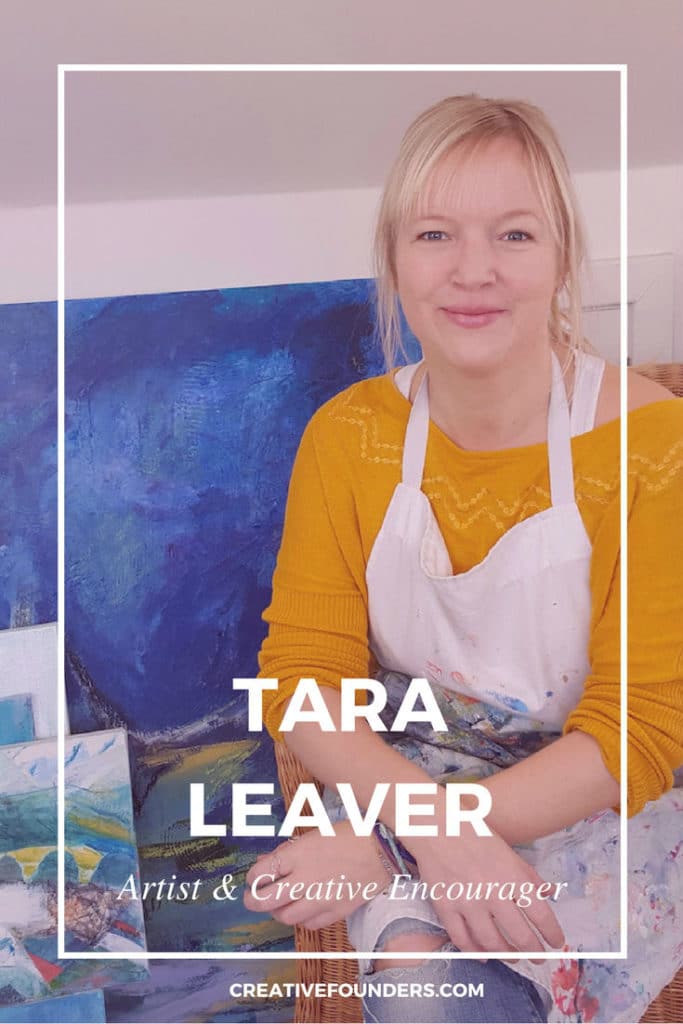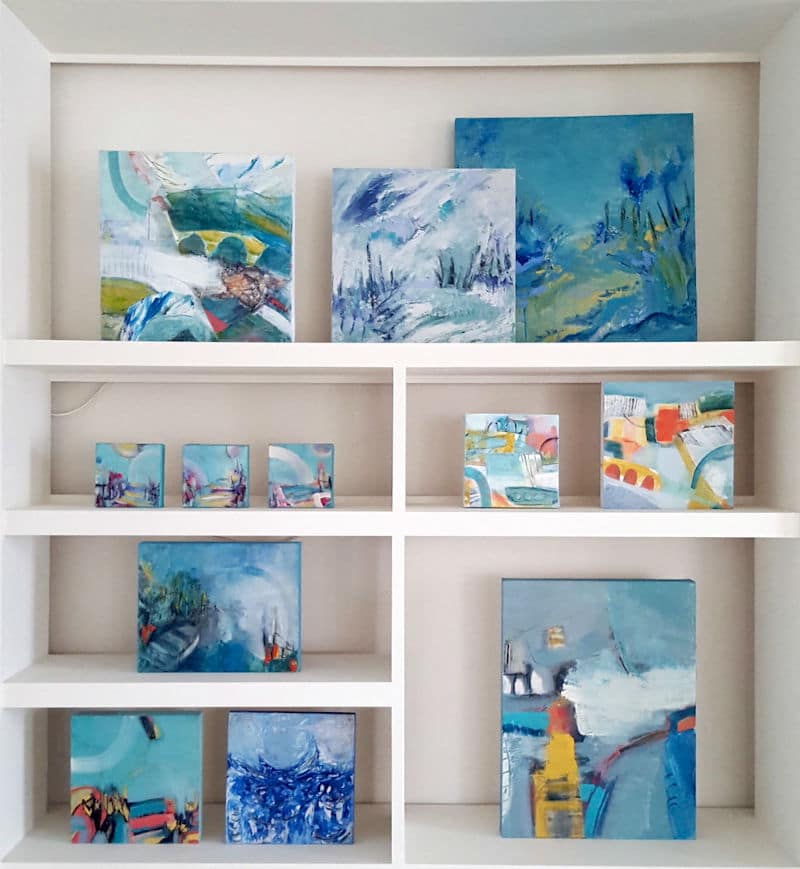IN THE STUDIO WITH ARTIST AND CREATIVE ENCOURAGER TARA LEAVER
We love speaking with inspiring artists who not only create great work but also motivate others to do the same, so we are super excited to chat to Tara Leaver, artist, teacher and creative encourager. Tara draws on her life experience to create free-flowing paintings and wall hangings, as well as courses and books that help artists tap into their true creative potential. Tara took the time to talk with us about her life, projects and gave us some insight into her #happyartistmovement.
IN THE STUDIO WITH ARTIST TARA LEAVER
Hi Tara, thanks for chatting with us! So you’re an artist, teacher, author and the creator of the #happyartistmovement. It definitely seems like you’re tapping into your full potential! But as we understand, you weren’t always able access your creativity. Can you tell us a bit about your journey and how you got this point?
Thanks for having me! It’s definitely been quite a meandering path! I loved art as a kid, and studied it up to foundation diploma level. Then things started getting messy. I had clinical depression, which in hindsight started around age 11, but went undiagnosed for a good decade after that, and even then the doctors seemed reluctant to call it what it clearly was. I remember one psychiatrist saying I couldn’t be that depressed because I smiled during a session!
So I believed there was something fundamentally wrong with me, and was experiencing the lifestyle consequences of that {periodic breakdowns, poor choices aimed to make me feel saner, messy relationships, and an often daily struggle to keep going}, and the creativity went right out of my life. I did keep choosing paths that led in that general direction; I trained as an interior decorator, and was a Montessori teacher for about six years, but in terms of personal artistic expression it was basically a barren wasteland!
Eventually, after one of the more spectacular breakdowns, and after being bedridden for a few months, I moved to a new city to start again. And that’s when the art started to come back. I had time while recuperating, which gave my creativity space to come forward, so I dived into the world of online art courses, relatively new at that time. Despite my emotional state, it was a very rich and interesting period. I connected with others around the world on similar paths, learned huge amounts about online courses, developed my own art, and essentially rediscovered my artist self. After a few years, a mentor suggested I create my own courses. Initially, I was adamant I wouldn’t be able to, but my curiosity got the better of me, and I’d made various observations as a student that I wasn’t seeing addressed anywhere, so I had a go. And here I am, four years and several courses later!
Although it’s not talked about as much as it should be, depression affects a huge percentage of the population, and we’re sure that every artist has had dark moments where they seriously doubted their own purpose and work. Do you have any tips for how to pull yourself out of that dark hole of negativity, fear and doubt?
I’ve found this to be so true. It wasn’t until I started talking about my depression that I realised how common it was, but no one was really talking about it.
My first tip would be to say, fully take on board the fact that depression is curable! So many of us don’t believe this; I didn’t for a very long time. {And I appreciate that for some people there are complications that make this very difficult.} But greater miracles than this happen every day; you don’t actually have to only learn to manage it for the rest of your life.
My other main piece of advice would be to get help. For most of us, it takes a unique combination of things that contribute to healing; there simply is no single solution that fits everyone. I had so much therapy and medication, and in the end it only ever proved a temporary fix, if it had any impact at all. What helped me heal fully was a combination of finding a mentor, learning various energy practices {including Tai Chi and Reiki}, an ongoing practice of discovering who I really am and learning to live according to that, and that period of getting my art back.
So I’d say, get support {and keep trying until you find the right kind and combination for you}, and if at all possible create some space in your life to devote to getting well. There are plenty of day to day things you can do – learning to take the inner critic less seriously and adjust old thought habits, journaling, even realising that the inner critic never actually goes away, you just learn to perceive it differently – but in my experience, without support and time, these will be temporary measures that don’t stick and only add to the struggle.

Can you tell us a bit more about the #happyartistmovement?
I have a little laugh to myself every time I think about it. 🙂 It’s both tongue in cheek and fundamental to my work. It came to me one day when I was trying to distill what I do into very few words {useful when you run a business!}, and challenged myself to make it brief enough for a hashtag. The phrase ‘happy artist movement’ popped into my head, and that was it!
Essentially, it’s about understanding that a happy artist is not some unrealistic fluffy concept about being happy all the time and only making ‘great’ art {good luck with that 🙂 }. It’s about experiencing the full spectrum of being an artist and accepting it all, even the icky parts, which, ironically, results in a much happier, richer, more fulfilling artist life. It focuses on process, because that’s where all the juicy information is; it’s about encouragement, experimentation, and developing what’s unique to you about your work. It’s about the richness of the full 360, not denying or rejecting the parts that feel uncomfortable or even painful. Process is a feedback system; if we learn to listen and not jump right to self criticism, it contains everything we need to become a happy artist in the fullest sense of the word.
There’s more on it here!!
A lot of your work focuses on your expression of what freedom feels like. What exactly is freedom to you?
Such a huge question! Part of the reason I love it is that it’s endlessly explorable. Fundamentally though, for me it’s about expressing the truth of who you are. It’s what many of us spend our lives seeking, even if perhaps we wouldn’t use that word. The way I see it, I’m free if I know myself, if I have clarity about who I am and how I need to live in order to thrive while I’m here. It’s not always what we think, or even what we would have chosen, and the path to freedom tends not to be the easy route because it requires a lot of inner work and an ongoing willingness to change and let go of things we thought we wanted.
But it’s not about compromise or sacrifice; that’s old paradigm thinking that leads to tight corners and dead ends. Freedom is expansive and it embraces everyone without judgement. I’m not saying I’ve mastered it, but it’s proving a very interesting focus in my life! And the more I embrace it, the more ‘me’ I feel, the richer my life becomes, and the better able I am to be of genuine and sustainable service.

Besides expressing yourself through your artwork, you have also made it your mission to help people tap into their creativity. In fact, your book Creative Spark: (Re)Igniting Your Creativity with Everyday Wisdom aims to do exactly that. Without giving away too much of the book, can you share some simple tips that people can use to get the creative mojo flowing?
Sure. It’s not really rocket science, but then I think we often want a nice complex solution we can research and talk about and ‘look into’, rather than just starting! The things that I’ve found to be consistently the most helpful when it comes to being – and staying – actively creative are:
having support – whether that’s a Facebook group that comes with a course, a teacher or mentor, a local group, a friend you make art with, or anything that enables you to find ready support, encouragement, and some gentle accountability. Art is usually a solitary experience but we don’t have to be isolated.
challenges or otherwise contained projects – Instagram challenges are great because you get the built in support mentioned above, specific prompts and a time frame. Open ended creativity is much easier to procrastinate on!
relentless self-kindness – it’s not very sexy but it makes an enormous difference to the frequency and enjoyment of your creative time. It’s also something that takes time to develop, so I’ll add patience in too. 🙂
You also create courses for artists that focus on a range of topics from getting motivated to developing your own unique style and refreshing a stale art practice.What can people expect when they sign up for one of your courses?
The one thing people will always find is totally non-judgmental encouragement. Often, especially when people are coming to art after a long hiatus, confidence is low, doubt is high, and what’s needed most is a space in which they feel not just safe but encouraged and supported to try new things. I know how hard it is not to judge yourself and your abilities, so I try to remove as many barriers to entry as possible!
The courses are very action oriented – concepts are great but they remain abstract without action to bring them into concrete experience – and are not about ‘doing as I do’ so much as they are about encouraging people to take what I offer and run with it, to add their own ideas. I try to offer this in a way that’s supportive and not daunting; nothing pleases me more than when a student says something like, ‘I didn’t follow the lesson exactly but this happened and I’m really pleased with what I learned/made’.
I’m also a huge art history fan, and often include slideshows and resources to explore that support the content and give it a wider context. And there’s always a Facebook group for support and sharing. Ultimately, I create the courses to be as fun, interesting, practical and motivating as possible.
With all these projects on your plate, you must be one busy lady! How do you handle the workload and find a balance between your work and your life outside your studio?
Quite honestly, I don’t! I don’t really believe in balance in the sense in which it’s often implied; that there can be some kind of equal split between work and life. My life and my work are the same. Sometimes I work late into the night; sometimes I’ll take an impromptu day off. All plans are flexible. It’s unconventional in that it requires trust that everything will get done in time, rather than creating detailed schedules and aiming for maximum productivity. Just those words make me shudder! And yet time and again, that trust proves itself; everything does get done, all external deadlines are met – as long as I follow the energy, respect that it’s cyclical and that I don’t always get to choose in advance exactly when things need to happen.
If the energy drops in the middle of creating a course, for example, I’ve learned that pushing on through doesn’t benefit me or the course. My best work always comes from paying close attention to what the energy is doing right now and following it. I don’t always get it right, but everything works out and I find this way of living infinitely richer and easier in the end. It goes back to what I was saying about freedom. It’s not about no structure whatsoever and winging it all the time {I tried that and it was stressful!}; it’s about knowing who you are, how you work best, being aware of the energy, and allowing them to flow together.
Are there any tools you use on a daily basis that you couldn’t live without?
In terms of painting, beyond the obvious paints, brushes and so on, currently, I’d say my Catalyst wedge. It’s a rubber tool that enables you to spread and manipulate the paint in smooth, translucent layers, and to carve into it for bold shapes.
In terms of my work, there are several! Aweber for sending emails, Teachery for hosting courses, Paypal and Stripe for taking payments, my website, my bookkeeper, and the freedom to create my own days. Oh, and post it notes. 🙂
You have a strong following on social media, both on Instagram and especially Pinterest. How important is social media to your creative business?
Hugely! The explosion of social media has evolved my business beyond what I could have imagined in offering greater opportunity for genuine connection, which is really the foundation of a good small business I think. Social media enables you to build the ‘know, like and trust’ factor by sharing not just what you’re offering, but a little bit about who you are as well, which is what people can relate to. And it’s fun, which helps. 🙂
I don’t see Pinterest as a social media platform, since it doesn’t really offer the personal connection that I find on Instagram and Facebook, but it has been instrumental in helping me spread the word about my work, and is by far the most common way people find me. I was fortunate to have my account picked up early on and offered to new members as an example of someone to follow, which accounts for at least some of the following I have there.
We love shining the spotlight on inspiring creative entrepreneurs like yourself. Can you tell us about one other female maker in your community who inspires you and why?
What a great question! Connie Solera, of Dirty Footprints Studio, was one of the first online art teachers I came across during my ‘hunker down, make art, and get well’ period, and I liked her immediately. She is so unequivocally herself, which is always what I love most in people, and is such an inspiration in so many ways. I’ve followed her journey for almost a decade, and I love how focused she is on integrity, depth, growth, and following your heart even when it’s hard, all with a great sense of humour. She’s made some courageous moves in her life which she talks about openly and honestly, and is also a lovely, warm, engaging person and great teacher.
Check out more of Tara Leaver’s work and please show your support!
Taraleaver.com
instagram.com/taraleaver
Facebook.com/taraleaver
Pinterest.com/taraleaver







